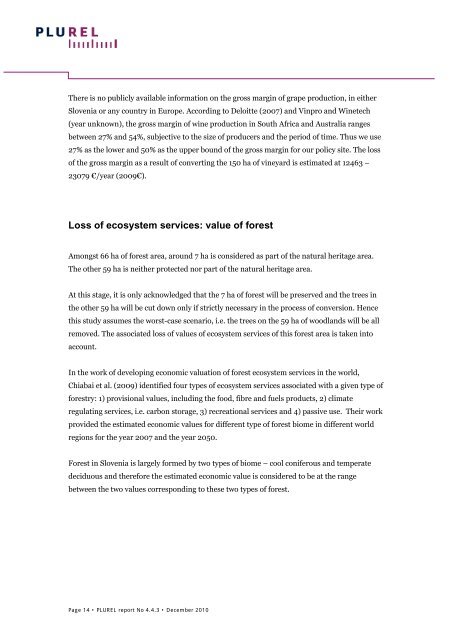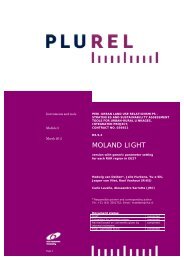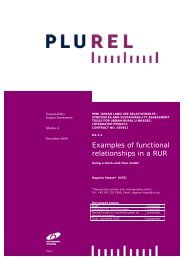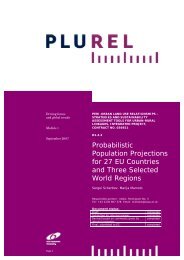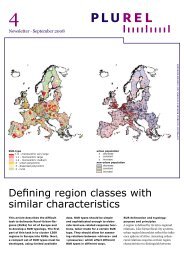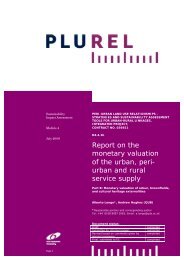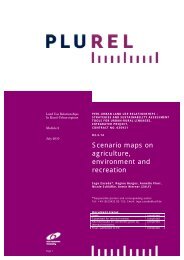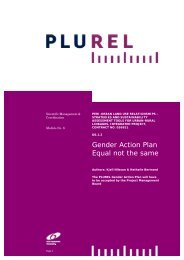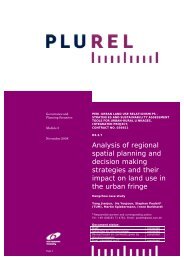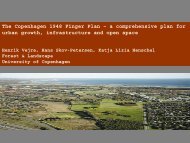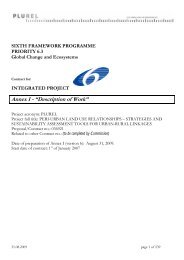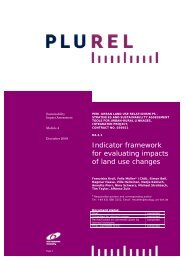Cost benefit analysis of peri-urban land use policy - Plurel
Cost benefit analysis of peri-urban land use policy - Plurel
Cost benefit analysis of peri-urban land use policy - Plurel
Create successful ePaper yourself
Turn your PDF publications into a flip-book with our unique Google optimized e-Paper software.
There is no publicly available information on the gross margin <strong>of</strong> grape production, in either<br />
Slovenia or any country in Europe. According to Deloitte (2007) and Vinpro and Winetech<br />
(year unknown), the gross margin <strong>of</strong> wine production in South Africa and Australia ranges<br />
between 27% and 54%, subjective to the size <strong>of</strong> producers and the <strong>peri</strong>od <strong>of</strong> time. Thus we <strong>use</strong><br />
27% as the lower and 50% as the upper bound <strong>of</strong> the gross margin for our <strong>policy</strong> site. The loss<br />
<strong>of</strong> the gross margin as a result <strong>of</strong> converting the 150 ha <strong>of</strong> vineyard is estimated at 12463 –<br />
23079 €/year (2009€).<br />
Loss <strong>of</strong> ecosystem services: value <strong>of</strong> forest<br />
Amongst 66 ha <strong>of</strong> forest area, around 7 ha is considered as part <strong>of</strong> the natural heritage area.<br />
The other 59 ha is neither protected nor part <strong>of</strong> the natural heritage area.<br />
At this stage, it is only acknowledged that the 7 ha <strong>of</strong> forest will be preserved and the trees in<br />
the other 59 ha will be cut down only if strictly necessary in the process <strong>of</strong> conversion. Hence<br />
this study assumes the worst-case scenario, i.e. the trees on the 59 ha <strong>of</strong> wood<strong>land</strong>s will be all<br />
removed. The associated loss <strong>of</strong> values <strong>of</strong> ecosystem services <strong>of</strong> this forest area is taken into<br />
account.<br />
In the work <strong>of</strong> developing economic valuation <strong>of</strong> forest ecosystem services in the world,<br />
Chiabai et al. (2009) identified four types <strong>of</strong> ecosystem services associated with a given type <strong>of</strong><br />
forestry: 1) provisional values, including the food, fibre and fuels products, 2) climate<br />
regulating services, i.e. carbon storage, 3) recreational services and 4) passive <strong>use</strong>. Their work<br />
provided the estimated economic values for different type <strong>of</strong> forest biome in different world<br />
regions for the year 2007 and the year 2050.<br />
Forest in Slovenia is largely formed by two types <strong>of</strong> biome – cool coniferous and temperate<br />
deciduous and therefore the estimated economic value is considered to be at the range<br />
between the two values corresponding to these two types <strong>of</strong> forest.<br />
Page 14 • PLUREL report No 4.4.3 • December 2010


